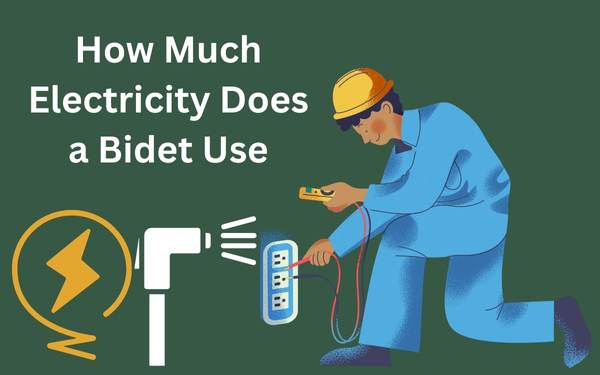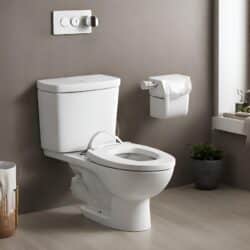Understanding the Power Usage and Electric Cost of Bidets: A Complete Guide

Today’s article explores into the topic of how much power different types of bidets consume. It also addresses questions related to the electric cost of operating a bidet, whether bidets increase electricity bills, and how much electricity bidets use.
Electric bidets, which are the most common type, can range in terms of energy consumption. The most efficient electric bidets use approximately 14 kilowatt-hours per month. On the other hand, the least efficient bidets can consume up to around 160 kWh/month, which is equivalent to about $27.52. However, these bidets typically only cost around $5-10 per month to operate.
The power consumption of a bidet can depend on various factors such as the frequency of use, the features used, and the settings used. For example, using luxurious features of a bidet like a heated seat, warm air dryer, warm water may increase the electrical costs.
Overall, the article aims to provide readers with a comprehensive understanding of the power consumption and cost implications of different types of bidets, and how to minimize these costs through energy-efficient practices. We will analyze the electric cost on the base of an average of 20 minutes of bidet toilet use.
See also:
Do Bidets Need Electricity?
Do you afraid of the electricity cost of the bidet? So, don’t worry because all bidets do not require electricity to function, as there are non-electric options available such as attachments, handheld sprayers, and manual seats that operate using water pressure alone.
However, electricity is required to power the additional features that are offered by electric bidet seats. These features include a water heater for warm water, a warm air dryer for reducing or eliminating the need for toilet paper, different spray patterns and modes, heated seats, an air deodorizer, automatic cleaning functions, and various other features such as body sensors, remote controls, and side panels.
Factors to measure the electricity requirement of a bidet
If bidets charm you too and, you’re planning to buy a bidet and considering how much energy consumes a bidet, then here are the factors that you will look out for.
Wattage
The wattage of the bidet will determine the amount of electricity it requires to operate. The wattage is usually listed on the product specifications or in the manual. We categorize the bidets from entry to a luxurious level. Entry-level bidets are 400W to 600W, and it ends on 1200 to 1400W in luxuries bidets
Usage frequency
The frequency of usage will also impact the electricity requirement. A bidet that is used several times a day will require more electricity than one that is used infrequently. So, will also keep in mind the number of people in your house and the daily average use of the bidet.
Features
Different features, such as a heated seat, warm air dryer, or nightlight, will increase the electricity requirement. It’s important to consider which features you need and how often you’ll use them. If you are living in a warm region, then you can ignore these features, but if you are residing in cold places then these features are the ultimate privilege in your bathroom.
Water heater
If the bidet has an in-built water heater, you’ll need to factor in the additional electricity required to heat the water.
Electrical requirements of a bidet-wattage, voltage and ampere
To move ahead and if your new to electrical knowledge or electrical terms, then it might be useful to learn these terms first.
Wattage/Watt
Wattage is a measure of the amount of electrical power being used by a device or system. It is calculated by multiplying the voltage by the amperage (W = V x A). Wattage represents the rate at which energy is being consumed or produced by an electrical device or system.
In simpler terms, wattage tells us how much energy an electrical device is using. The higher the wattage, the more energy is being used by the device.
For example, a device that uses 100 watts for an hour will consume 100 watt-hours (Wh) of energy, but a device that uses 50 watts for two hours will consume the same amount of energy.
Voltage
Voltage is a measure of electrical potential difference, or the force that drives the flow of electrical current in a circuit. It is often referred to as “volts” and is a crucial component of the electrical system for bidets.
To understand voltage, think of it like water pressure in a pipe. Just as water pressure pushes water through the pipe, voltage pushes electrical current through a circuit. The higher the voltage, the greater the force driving the flow of current.
When it comes to bidets, the voltage required will depend on the specific model and features. Most bidets are designed to be used with either a 120V or 240V electrical system. Before going to purchase a bidet it is important to match the voltage of your electrical system to the voltage requirements of your bidet to ensure proper operation.
For example, a bidet that is designed to be used with a 240V electrical system will not work properly if it is connected to a 120V electrical outlet. This could cause the bidet to operate at a reduced capacity, or not operate at all.
Amperes
Amperes, also known as amps, are a unit of measurement that indicates the flow of electrical current in a circuit. When it comes to bidets, understanding the amperage required is important to ensure that your electrical system can support the device you want to install.
To calculate the required amperage for a bidet, you need to first determine the wattage of the device and the voltage of your electrical system. The formula for calculating amperage is:
Amperage = Wattage ÷ Voltage
For example, a bidet seat has a wattage of 500W and is designed to be used with a 120V electrical system. To calculate the required amperage:
Amperage = 500W ÷ 120V = 4.17A
According to manuals of dozens of bidet 15-amp circuit is recommended.
How much electricity does a bidet use, and does its use result in higher electricity bills?
After examining multiple bidet manuals, it has been observed that entry-level electric bidet seats consume lower wattage while in use, usually around 400 watts, but they consume the most energy overall, using approximately 150 kilowatt-hours per month.
On the other hand, luxury bidets have a higher maximum power consumption rating, with some models consuming up to 1200 watts. However, these luxury bidets are much more efficient on the whole, using only around 9 kilowatt-hours per month.
The power consumption of a bidet seat depends on whether it has a tank or not. On the base of this factor I categories the bidet on these three types.
Tank Type Bidet:
A tank-type bidet is a traditional bidet that has a water tank attached to it. It heats the water inside the tank, which is then used for cleaning. Tank-type bidets typically consume 600-800 watts of electricity. The electricity consumption of a tank-type bidet depends on the temperature of the water, the length of use, and the frequency of use. Since the water tank is heated continuously, it can consume more electricity in the long run, even if it uses less electricity during each use.
Tankless Type Bidet:
A tankless bidet, also known as an on-demand bidet, does not have a water tank. Instead, it heats the water on-demand, as it is needed. This type of bidet typically consumes 1200-1400 watts of electricity, which is higher than the electricity consumption of a tank-type bidet. However, since it only heats the water when it is needed, it can be more energy-efficient in the long run, especially for infrequent users.
Hybrid Type Bidet:
A hybrid bidet is a combination of tank and tankless bidets. It has a small water tank that is used to preheat the water, and then the tankless system heats the water to the desired temperature. This type of bidet typically consumes 800-1000 watts of electricity, which is in between the electricity consumption of tank and tankless bidets. The monthly electricity consumption of a hybrid bidet depends on the frequency of use and the length of use, but it can be more energy-efficient than a tank-type bidet while still providing the convenience of preheated water.
Luxurious bidet seats only use maximum wattage during a wash cycle with the temperature set to its maximum level.
This shows us that the maximum power consumption rating alone cannot accurately determine the overall energy efficiency of a bidet.
Moreover, when considering the electric cost of a bidet, it’s important to factor in the savings in toilet paper. While the electrical costs of an electric bidet may not completely cut out the savings in toilet paper, actually it is the overall cost savings in the long term.
For maximum savings, a non-electric option and a bidet with a tankless water heater may be the best option.
What is the power consumption of a bidet in watts/Kwh/Cost
How to calculate the power consumption of a bidet
Before calculating the power consumption of a bidet, let see the latest electricity cost per Kwh in 7 famous cities of USA.
Electricity Cost of 7 famous cities of USA [Feb-2023]
| City | Region | Cost per Kwh |
| New York | Middle Atlantic | 0.243 |
| Los Angeles | Pacific | 0.271 |
| Chicago | East N. Central | 0.151 |
| Houston | West S. Central | 0.181 |
| Miami | South Atlantic | 0.147 |
| Denver | Mountain | 0.153 |
| Washington, D.C. | South Atlantic | 0.155 |
| Average cost of electricity per Kwh in the USA | 0.172 |
Note: The average cost of electricity per kWh in the USA is calculated as the simple average of all the values in the data of US 7 famous cities.
What is the power consumption of a bidet in watts?
When it comes to the maximum power consumption when operated, the wattage usage can vary greatly among different types of bidets. Basics-level electric bidet seats, with no dryer, typically have a maximum power consumption of 300 watts (W).
Basics-level electric bidet seats with dryers typically have a maximum power consumption of 500 W.
Mid-range electric bidet seats with hybrid heaters typically have a maximum power consumption of 800 W.
Luxury electric bidet seats with tankless heaters typically have a maximum power consumption of 1250 W.
For example, we have three bidets and different wattages 500W, 800W, and 1250W, here is how we can calculate the power consumption of each bidet.
Power consumption per day.
To calculate how much electricity each bidet consumes per day, we can use the formula:
Electricity (in watts) = Power (in watts) x Time (in hours)
Let’s assume you use each bidet for 30 minutes per day, or 0.5 hours. Then the electricity consumed by each bidet per day can be calculated as:
Bidet with 500 watts: 500 watts x 0.5 hours = 250 watt-hours (Wh)
Bidet with 800 watts: 800 watts x 0.5 hours = 400 watt-hours (Wh)
Bidet with 1250 watts: 1250 watts x 0.5 hours = 625 watt-hours (Wh)
Monthly electricity usage and costs for bidets in kilowatt-hours.
We will continue the above mentioned example, let’s convert watts to kilowatt-hours.
To convert watt-hours to kilowatt-hours (kWh), we need to divide by 1000. So the electricity consumed by each bidet per day in kWh is:
Bidet with 500 watts: 250W / 1000 = 0.25 kWh
Bidet with 800 watts: 400W / 1000 = 0.4 kWh
Bidet with 1250 watts: 625W / 1000 = 0.625 kWh
Monthly electricity usage.
Now, let’s assume there are 30 days in a month. To calculate how much electricity each bidet consumes per month, we can simply multiply the daily consumption by 30 (KWh x 30):
Bidet with 500 watts: 0.25 kWh x 30 = 7.5 kWh
Bidet with 800 watts: 0.4 kWh x 30 = 12 kWh
Bidet with 1250 watts: 0.625 kWh x 30 = 18.75 kWh
Average cost of electricity per KWh.
To calculate the average cost of electricity per kWh for each bidet, we would need to know the cost of electricity in your area. Let’s consider the average cost of electricity is 0.172 per kWh. Then the cost of each bidet per day can be calculated as:
Bidet with 500 watts: 0.25 kWh x $0.172 = $0.043 per day
Bidet with 800 watts: 0.4 kWh x $0.172 = $0.0688 per day
Bidet with 1250 watts: 0.625 kWh x $0.172 = $0.1075 per day
And the cost of each bidet per month can be calculated as:
Bidet with 500 watts: 7.5 kWh x $0.172 = $1.29 per month
Bidet with 800 watts: 12 kWh x $0.172 = $2.064 per month
Bidet with 1250 watts: 18.75 kWh x $0.172 = $3.225 per month
This data is based on, if we use a bidet with different wattages for only 30 minutes per day.
To be clearer about the bidet electricity usage, it’s always recommended to check the product manual or ask the manufacturer for more accurate information. It is important to mention that the power consumption of a bidet can depend on various factors such as the frequency of use, the features used, and the settings used.
To minimize electricity costs, habits like using the eco mode (if available), foregoing the heated seat functions and keeping the water and air drying temperature to the lowest comfortable level can go a long way in reducing electrical costs.
How Many Amps Does a Bidet Use?
The amount of amperes used by a bidet varies depending on the type of bidet.
Basics-level electric bidet seats typically use around 4 amperes per second, while luxury bidets can use up to 10 amperes per second.
This is because Basic-level bidets typically lack features such as a warm air dryer and thus have a lower maximum power rating. However, entry-level bidets are less efficient and use more energy overall.
When compared to other common household appliances, bidets use relatively low amperes. Lights and small appliances typically use 15 to 20 amperes, while larger appliances can use up to 50 or 60 amperes. The table below provides a comparison of the average amp draw of different appliances.
| Appliance | Power Consumption (W) | Amperes (A) | Monthly kWh |
| Refrigerator (18 cu. ft.) | 150 | 1.3 | 90 |
| Window AC (10,000 BTU) | 1200 | 10 | 300 |
| Electric Range | 3000-4000 | 25-33 | 150-200 |
| Dishwasher | 1200 | 10 | 30 |
| Washing Machine | 500-1000 | 4.2-8.3 | 30-60 |
| Dryer | 1800-5000 | 15-42 | 100-300 |
| Water Heater (40 gallons) | 4500 | 37.5 | 1350 |
| Bidet (Entry-level) | 400 | 3.3 | 45 |
| Bidet (Luxury) | 1200 | 10 | 270 |
Understanding the Power Usage and Electric Cost of Bidets-Conclusion
In summary, some bidets do not necessarily require electricity to operate. Non-electric bidets, such as attachments, handheld sprayers, and manual seats, work off of water pressure alone. However, electric bidets offer additional features such as water heating, warm air drying, different spray patterns, and heated seats, which require electricity to function. The cost of electricity consumption should be taken into account when deciding to switch to a bidet, along with other factors such as water usage, toilet paper savings, and environmental benefits. It’s important to note that there are bidets available that are energy efficient, making the electricity cost minimal. Ultimately, it’s important to consider your budget and preferences before making a decision.
Understanding the Power Usage and Electric Cost of Bidets- FAQs
What kind of electrical outlet is needed for a bidet?
A standard 110-120V electrical outlet is required for most bidets. Some models may require a 220-240V outlet, so it’s important to check the specifications of your bidet before installation.
Is it safe to use a bidet with an older electrical system?
It’s always recommended to consult with a licensed electrician to ensure that your electrical system can handle the additional load of a bidet. Older electrical systems may need to be updated to meet the current electrical codes and safety standards.
Can I use an extension cord for a bidet?
No, it’s not recommended to use an extension cord for a bidet. Extension cords can overheat and pose a fire hazard, so it’s best to have a dedicated electrical outlet installed for the bidet.
Can I install a bidet if my electrical panel is full?
It’s possible to install a bidet even if your electrical panel is full, but you’ll need to have a licensed electrician install a sub-panel to accommodate the additional electrical load.
Do I need a GFCI outlet for my bidet?
A Ground Fault Circuit Interrupter (GFCI) outlet is not mandatory, but it’s highly recommended for added safety. Bidets require electricity to function, and a GFCI outlet will interrupt the electrical circuit in case of a ground fault, reducing the risk of electrical shock.
Can I plug my bidet into a bathroom outlet?
Yes, you can plug your bidet into a bathroom outlet as long as it’s a standard 110-120V outlet and has enough electrical capacity to handle the additional load of the bidet.
What should I do if I’m not comfortable with electrical installations?
If you’re not comfortable with electrical installations, it’s best to have a licensed electrician handle the installation of your bidet. They’ll be able to assess your electrical system, make any necessary updates, and safely install the bidet to ensure it functions correctly and safely.




